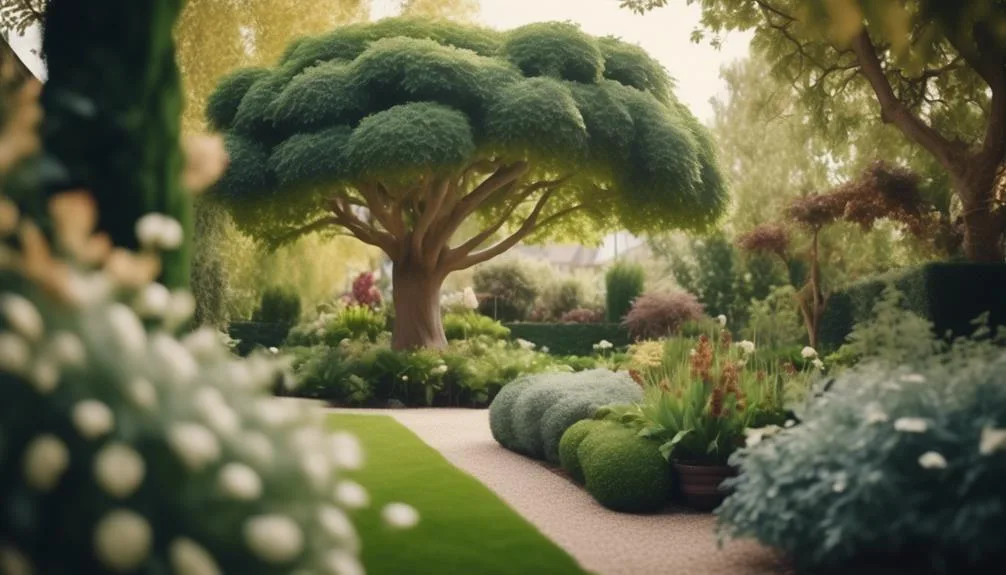Discover the simple steps to create a beautiful sycamore tree feature in your garden.
Picture the charm of a sprawling sycamore tree providing shade and beauty.
Learn how to choose the right spot and enhance the overall look of your outdoor space.
This majestic tree can become the focal point, adding natural grandeur to your garden.
Join us as we explore the ways to elevate your garden with the timeless appeal of a sycamore tree.
Selecting the Right Location
To ensure the healthy growth and development of your sycamore tree, it's crucial to select a location that provides ample sunlight, well-drained soil, and sufficient space for its mature size.
Sycamore trees thrive in well-drained soil with a slightly acidic to neutral pH. They also require full sunlight exposure to flourish, so choose a spot in your garden that receives at least 6-8 hours of direct sunlight daily.
When planting, ensure the tree has enough space to spread its roots and branches without any crowding from other plants or structures. Additionally, consider a watering schedule that keeps the soil consistently moist but not waterlogged, especially during the first few years of growth.
Protect your young sycamore tree from lawnmowers and trimmers, and consider using tree guards to shield the bark from damage.
Preparing the Planting Site
When preparing the planting site for your sycamore tree, ensure the soil is well-drained and the location receives ample sunlight for optimal growth. Here are some essential steps to consider:
- Soil preparation: Clear the planting site of any debris and ensure the soil is well-drained to prevent waterlogging, which can be detrimental to the tree's health.
- Sunlight exposure: Choose a spot that gets at least 6-8 hours of direct sunlight daily to support the sycamore tree's photosynthesis and overall vigor.
- Shade requirements: While sycamore trees thrive in sunlight, they also benefit from some shade during the hottest part of the day. Consider nearby structures or existing trees that may provide this balance.
- Test the soil pH: Conduct a soil test to ensure the pH level is suitable for sycamore trees, aiming for a slightly acidic to neutral range for optimal growth.
With these considerations in mind, you can create an ideal environment for your sycamore tree to flourish.
Planting the Sycamore Tree
Consider selecting a well-drained, sunny spot with a touch of shade for optimal growth when planting your sycamore tree in the garden. Sycamore trees thrive in various soil types, including loamy, well-draining soil. When planting, ensure the tree has enough space to grow and develop. A spacing of 25-30 feet between trees is ideal to allow for proper root and canopy expansion. It's crucial to dig a hole that is twice as wide as the root ball but just as deep. Add organic matter to the soil and water the tree deeply after planting. As for pruning, remove any dead or damaged branches in late winter or early spring. Sycamore trees benefit from regular watering, especially during dry spells, to maintain healthy growth.
—
| Tree Spacing | Soil Requirements |
|---|---|
| 25-30 feet | Loamy, well-draining |
| Pruning Techniques | Watering Schedule |
| Remove dead/damaged branches in late winter or early spring | Regular watering, especially during dry spells |
Providing Proper Care and Maintenance
Now that you have planted your sycamore tree in the garden, it's time to ensure it receives proper care and maintenance to support its healthy growth and development.
Here are some essential tips to help you maintain your sycamore tree:
- Watering Schedule: Establish a regular watering schedule, especially during dry spells, to keep the soil consistently moist but not waterlogged.
- Pruning Techniques: Prune your sycamore tree during the dormant season to remove dead or diseased branches and maintain its shape and structure.
- Fertilizing Methods: Use a balanced fertilizer in the early spring to provide essential nutrients for healthy growth.
- Pest Control: Keep an eye out for common pests such as aphids or scale insects and employ appropriate pest control methods if necessary.
Enhancing the Tree Feature in Your Garden
To enhance the tree feature in your garden, consider incorporating complementary plants and hardscaping elements to create a visually appealing and harmonious landscape.
Enhancing the aesthetics around the sycamore tree can be achieved by adding colorful flowers, such as hydrangeas or astilbes, which can bloom throughout the growing season, providing a stunning backdrop to the tree.
Additionally, planting ground covers like creeping phlox or hostas can help create a lush and vibrant base around the tree trunk.
Introducing hardscaping elements like a decorative mulch ring or a stone pathway leading up to the tree can further elevate the overall look of the garden.
Moreover, attracting wildlife to the area can be accomplished by incorporating bird feeders, nesting boxes, and butterfly-friendly plants, enriching the ecosystem and adding liveliness to your garden.
Conclusion
Now that you have the knowledge and tools to create a captivating sycamore tree feature in your garden, it's time to bring your vision to life.
Select the ideal spot, prepare the area, and plant your tree with care.
Remember, ongoing maintenance is key to ensuring the thriving of your sycamore.
With dedication and nurturing, your sycamore tree will blossom into a stunning focal point, enriching your outdoor sanctuary.
Mark Hoffman is a dedicated arborist and tree care specialist with over a decade of experience. His love for trees began when he visited Yosemite National Park as a teenager and was awestruck by the giant sequoias. Mark pursued his passion by studying forestry at Michigan Technological University, where he earned a Bachelor of Science degree.
Since then, he has worked tirelessly in the field of arboriculture, helping to preserve and protect trees in his community. His expertise and dedication have made him a respected leader in the industry and a valuable resource for anyone seeking advice on tree care.
